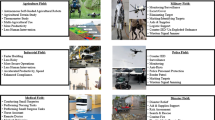Abstract
Radio-frequency-based intelligent proximity sensors for detection as well as identification of objects were presented. A resonant structure is constructed that creates a near field with three-dimensional extent in the same order of magnitude as the physical size of the objects to be detected and identified. As an object is brought within the extent of the near field, a redistribution of electric and magnetic fields take place, modifying the reflection coefficient (i.e., impedance) of the resonant structure monitored through a port. The object under test, with its own natural frequencies, perturbs the resonant frequency of the monitoring structure to create a unique set of natural frequencies (poles and zeros). These poles and zeros, depending on the size, shape, material composition, and orientation, constitute the RF signature of the object and can be determined from the measurement of reflection coefficient. This technique can be used to create smart shelves for automated inventory without the need for tagging, as well for a variety of security applications. The technique can be used for metallic and non-metallic objects, as well as for a combination thereof. The basic principle is illustrated by way of electromagnetic simulation, and implementation of a smart tray using the principle is presented.













Similar content being viewed by others
References
D’Alessandro, A.; Buffi, A.; Nepa, P.; Isola, G. (2012) RFID-based smart shelving storage systems. Microwave Conference Proceedings (APMC), Asia-Pacific.
Qing X, Chen ZN (2009) Characteristics of a metal-backed loop antenna and its application to a high-frequency RFID smart shelf. IEEE Antennas and Propagation Magazine 51(2):26–38. doi:10.1109/MAP.2009.5162014
Schriebl, W., Winkler, T., Starzacher, A., Rinner B. (2009) A pervasive smart camera network architecture applied for multi-camera object classification. ICDSC 2009 Third ACM/IEEE International Conference. doi: 10.1109/ICDSC.2009.5289377
Balanis CA (1982) Antenna theory—analysis and design. Harper and Row, New York
Mukherjee S. (2011) Method to detect and identify objects using intelligent proximity sensors. US Provisional Patent Application January 2011
Mukherjee, S. (2010) Non-invasive level measurement for liquid or granular solids. US Provisional Patent Application May 2010
Mukherjee S (2010) Non-invasive measurement of liquid content inside a small vial. Proc IEEE Radio and Wireless Symposium (RWS), New Orleans
Acknowledgment
The author thanks Sanschip Inc. of San Jose, CA, USA for supporting the work.
Author information
Authors and Affiliations
Corresponding author
Rights and permissions
About this article
Cite this article
Mukherjee, S. Detection and identification of objects based on radio-frequency signatures. Ann. Telecommun. 68, 459–466 (2013). https://doi.org/10.1007/s12243-013-0373-8
Received:
Accepted:
Published:
Issue Date:
DOI: https://doi.org/10.1007/s12243-013-0373-8




